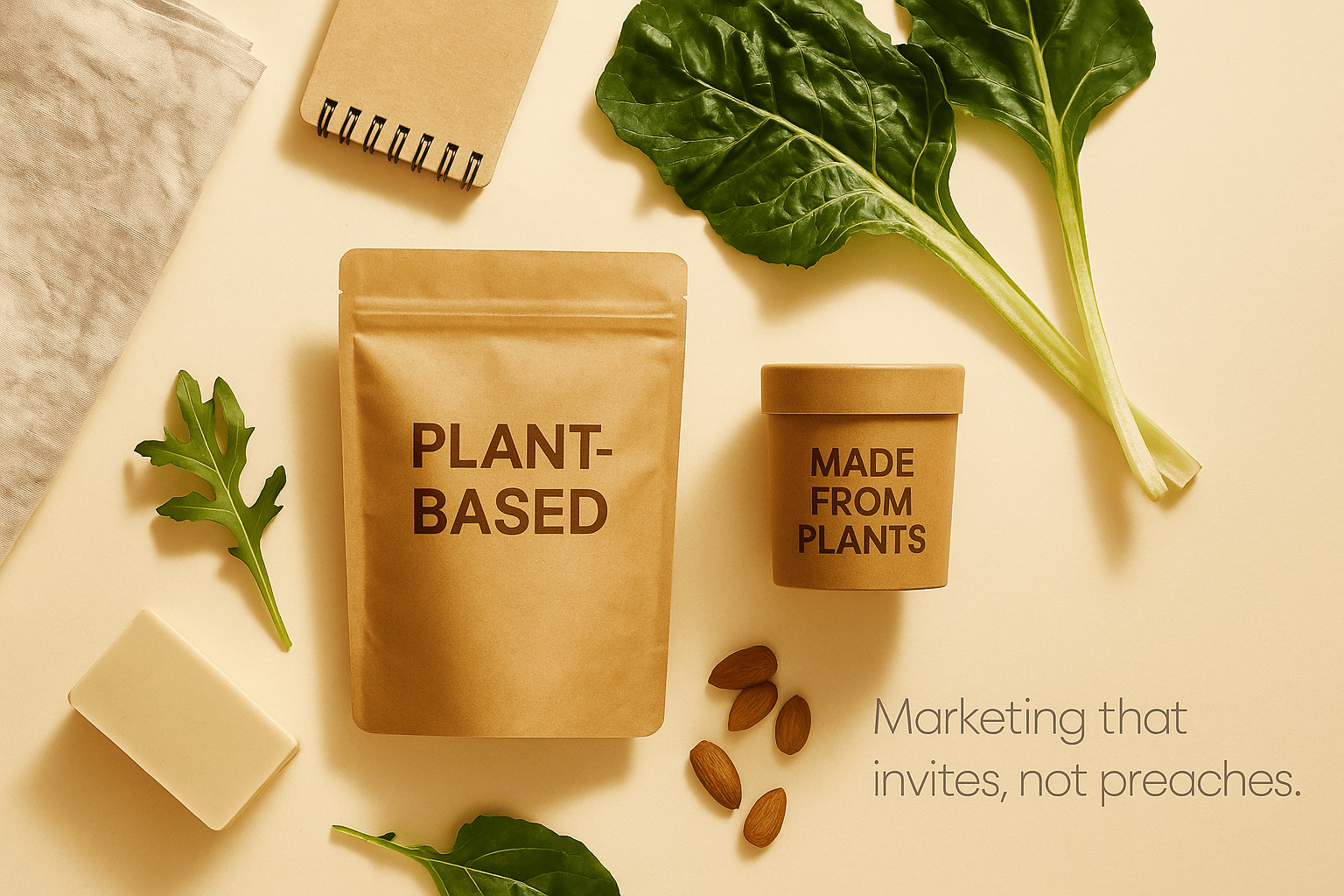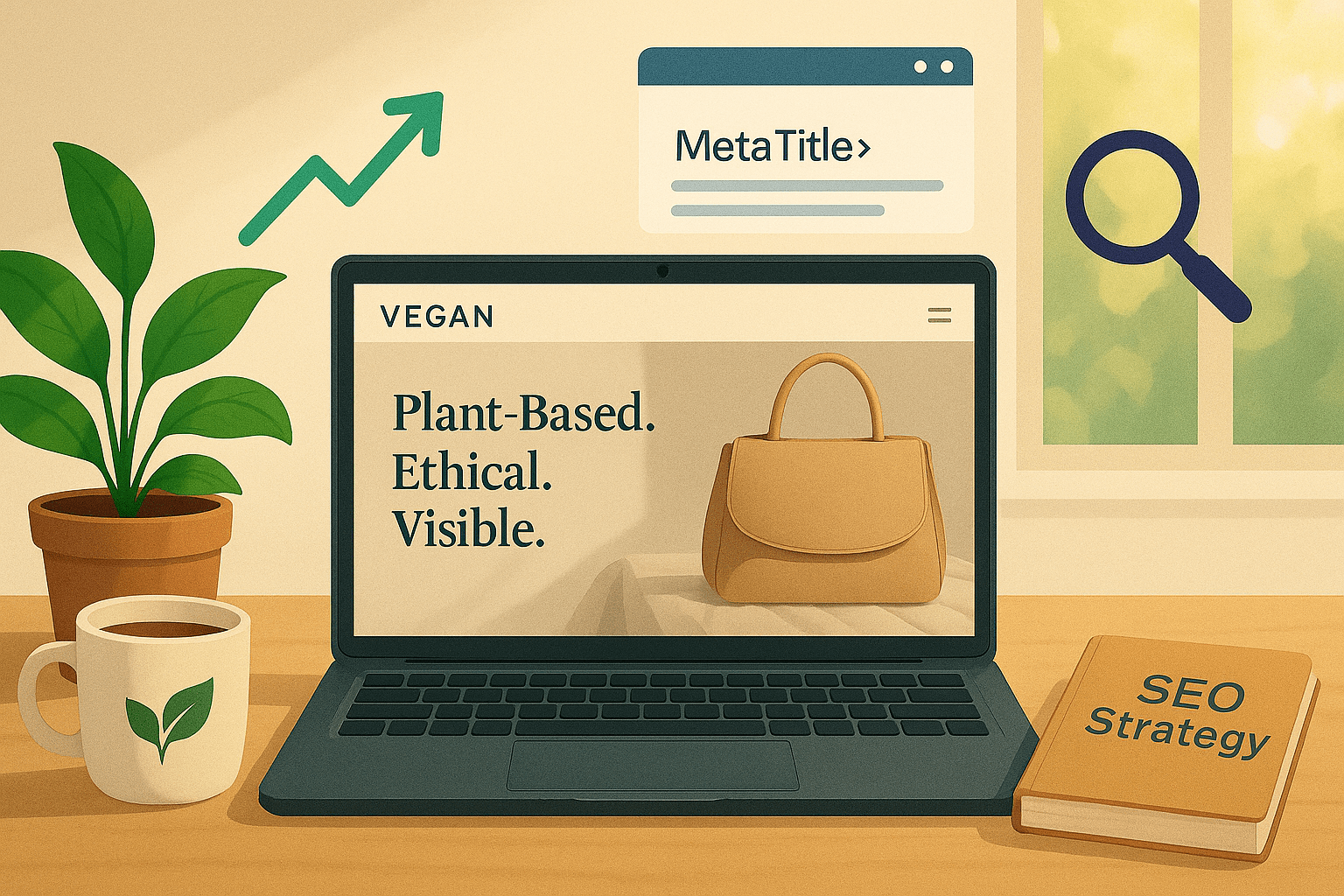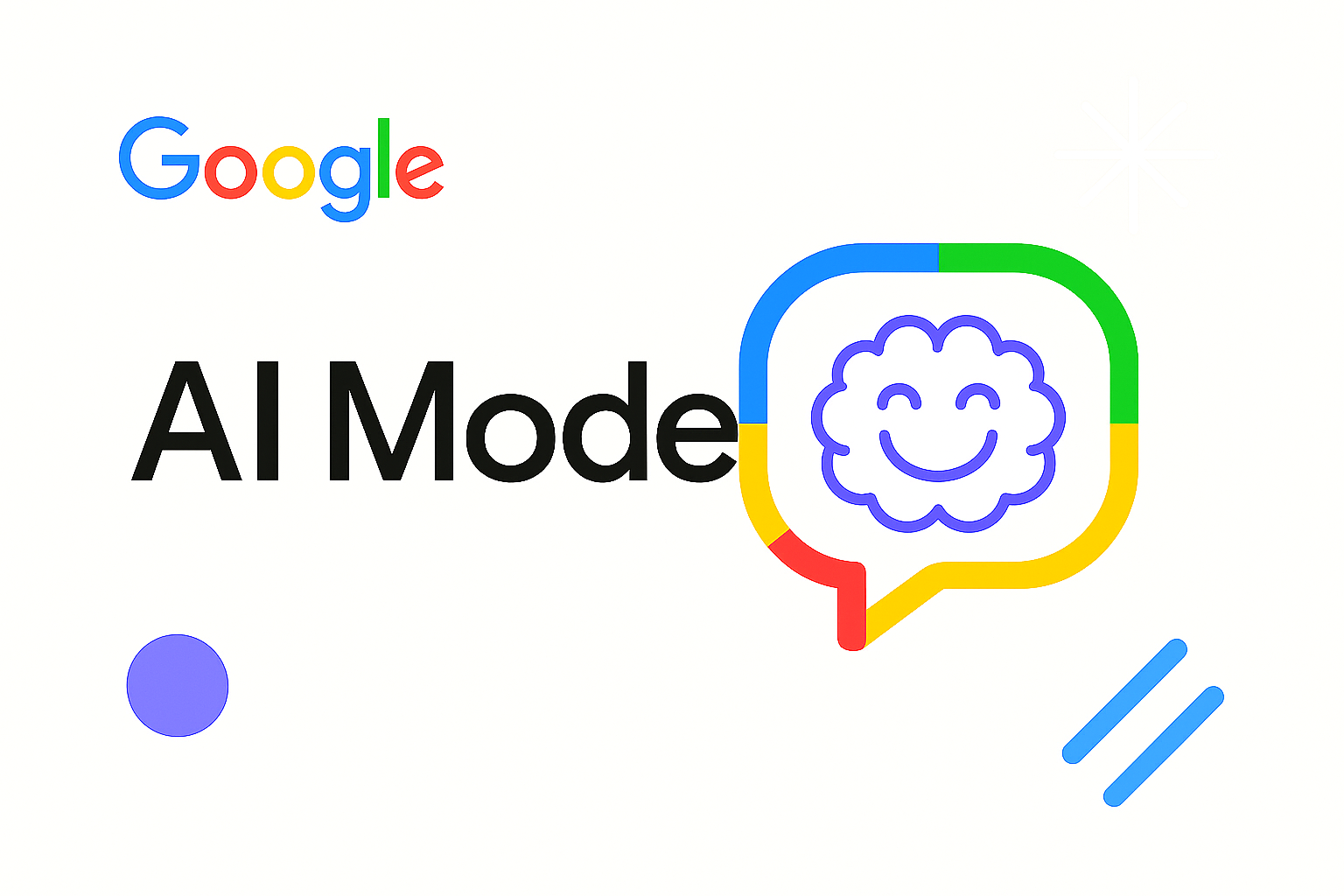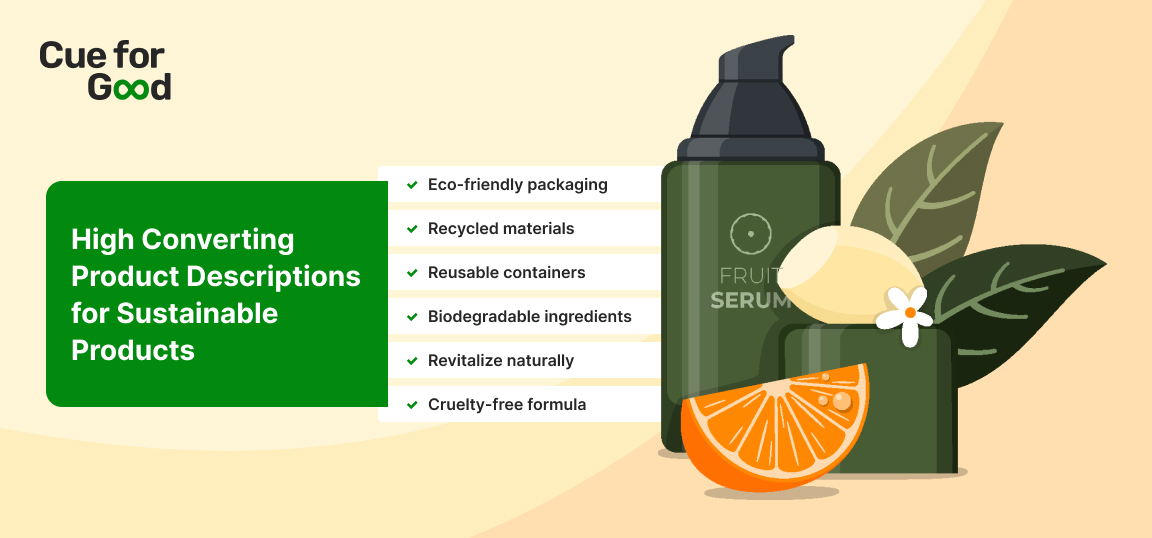
High Converting Product Descriptions for Sustainable Products
by Nida DanishThe Growing Demand for Sustainable Products
It’s fascinating how consumers are increasingly leaning towards environmentally friendly products. In fact, recent studies have shown that this shift is more evident than ever before.
A global study done in 2023 by Ipsos reveals that 68% of consumers worldwide consider it important that the brands they buy from are environmentally friendly and sustainable.
This growing awareness and concern for sustainability is driving significant changes in shopping behaviors. It offers a huge opportunity for businesses to tap into a market that values ecological responsibility.
The Power of Persuasive Copy in Driving Sales
You’ve likely heard the saying, “words matter,” and this is quite evident in the world of eCommerce. Persuasive copy can influence purchasing decisions and drive sales.
For sustainable products, this means clearly communicating the environmental benefits and ethical considerations that set your products apart.
It’s about weaving a story that resonates deeply with your audience, igniting a sense of purpose and belonging. Every word becomes a tool for change, and every sentence becomes a call to action.
The Role of Product Descriptions in Showcasing Sustainability
A well-crafted product description does more than just inform the customer; it highlights the sustainability of your products.
But it’s not enough to simply tout your products as “green” or “eco-friendly.” Today’s consumers are savvy, they demand transparency and authenticity. They want to know the story behind the product, the journey from sourcing to production to their doorstep. And it’s your product description that serves as the conduit for this narrative.
exemplifies sustainability with their 100% natural, compostable bowls made from repurposed coconut shells. Each unique bowl supports a plastic-free lifestyle, comes with a lifetime guarantee, and aids farmers and artisans globally.
Take the example of Coconut Bowls. Their product description clearly conveys sustainability with 100% natural, compostable bowls made from repurposed coconut shells. Each unique bowl supports a plastic-free lifestyle, is made by global artisans, and includes a lifetime guarantee, highlighting their positive environmental impact.
Pura is another eco-friendly baby wipes and diaper brand that stands out for its commitment to transparency with packaging and waste. Their product descriptions highlight their dedication to sustainability, making it evident how each purchase supports eco-friendly practices.
Pura utilizes recyclable paper packaging, promotes allergy and eczema safety, and boasts a 100% carbon-neutral business model. Pura is prioritizing sustainability alongside safety in baby care, with a focus on both the little ones and the planet.
By providing insights into your sustainability initiatives, whether it’s using recycled materials, reducing carbon emissions, or supporting fair labor practices, you’re building trust with your audience (more on this later). You’re demonstrating your commitment to sustainability in a practical and relatable way.
Understanding Your Target Customers
Who are eco-conscious consumers?
They’re individuals who prioritize sustainability in their purchasing decisions, motivated by a deep-seated desire to make a positive impact on the planet. They’re the ones who carefully scrutinize labels, seeking out products that match their values of environmental conservation and social responsibility.
But understanding eco-conscious consumers needs more than knowing what they buy; it’s understanding why they buy.
- What drives them to choose sustainable options over conventional ones?
- Is it a desire to reduce their carbon footprint?
- A commitment to supporting ethical labor practices?
- A desire to opt for healthier food alternatives?
- Or perhaps a belief in the power of collective action to effect meaningful change?
Whatever the case may be, the key is to speak directly to the hearts and minds of your eco-conscious customers. Take the time to truly understand your target customers. Empathize with their concerns, and align your product descriptions with their aspirations.
Creating Buyer Personas for Sustainable Product Descriptions
Creating buyer personas is a powerful tool for gaining deeper insights into eco-conscious consumers. Start by conducting thorough research to identify key characteristics of eco-conscious consumers, such as their age, income level, lifestyle preferences, and environmental beliefs.
Once you have a clear understanding of your target audience, use this information to craft buyer personas that bring them to life. Give each persona a name, backstory, and set of attributes that reflect the diverse range of eco-conscious consumers you’re targeting.
For example, you might create personas such as “Green-minded Greg,” a millennial professional who values sustainability, seeks out eco-friendly products for his home, and prefers products with minimal packaging.
Source: SketchBubble
With your buyer personas in hand, you can now tailor your product descriptions and other supporting content like blogs, manuals/brochures, videos, etc. to speak directly to the needs and preferences of each segment of your target audience.
Crafting Compelling and Informative Descriptions
We have already discussed above how your descriptions should do more than list features; they should clearly explain the benefits and advantages of your products while weaving a narrative that resonates with your customers. But if you are unsure how to start, then keep reading.
Highlighting the Environmental Impact of Sustainable Choices
One of the strongest selling points for sustainable products is their positive environmental impact. Emphasize how purchasing your products contributes to reducing carbon footprints, conserving natural resources, or supporting ethical labor practices. Detail the specific materials used, such as recycled plastics or sustainably sourced wood, and explain the benefits of these choices.
Vintner’s Daughter demonstrates product description by emphasizing sustainability and social responsibility. They detail their use of FSC-certified packaging, climate-neutral practices, and ethically sourced, cruelty-free, and vegan ingredients. Additionally, their commitment extends to donating 2% of their purchases to charities supporting women and children and holding the California Green Business Certification.
Using Sensory Language to Create an Immersive Experience
Describe the textures, scents, colors, and other sensory details that make your product unique. For instance, instead of simply stating that a candle is made of soy wax, describe the smooth, creamy texture of the wax and the gentle, soothing aroma that fills a room when the candle is lit.
Sensory language engages the reader’s senses and creates a vivid mental picture of your product. It helps customers imagine using the product in their own lives, enhancing their overall shopping experience and increasing the likelihood of a purchase.
Earth Rated crafts descriptions with sensory knowledge, ensuring their products engage pets owners. Their enrichment toy, for instance, entices with its promise of filled treats, while its ribbed ergonomic design invites gripping akin to holding a bone.
Made from responsibly sourced natural rubber, it rolls, twists, and moves unpredictably, providing mental stimulation. Additionally, Earth Rated emphasizes sustainability, as their products are top-rack dishwasher safe, ensuring easy cleanups and promoting mess-free fun.
Optimizing for Search Engines and Conversion Rates
Effective SEO ensures your products are easily discovered by eco-conscious shoppers, while compelling descriptions encourage them to make a purchase. Let’s explore how to achieve this balance.
Choosing Relevant Keywords for Sustainability-Focused Shoppers
Selecting the right keywords is the foundation of effective SEO. For shoppers who care about sustainability, use terms that resonate with their values.
Keywords like “organic,” “recycled,” “biodegradable,” “eco-friendly,” and “sustainable” should be strategically added to your product titles, descriptions, and tags.
Also, consider using long-tail keywords such as “sustainable bamboo toothbrush” or “biodegradable packaging solutions” to capture more specific search queries.
Incorporating SEO Techniques in Product Descriptions
To optimize your product descriptions for search engines, you can follow these best practices:
- Keyword Placement: Use your chosen keywords naturally within the product title, description, and bullet points. Avoid keyword stuffing, which can harm readability and SEO.
- Meta Descriptions: Create convincing meta descriptions that include your primary keywords. These brief summaries appear in search results and should encourage potential customers to click through and reach your product page.
- Clear, Concise Language: Use straightforward language that clearly conveys the benefits and features of your product. This not only helps with SEO but also makes sure that your descriptions are easily understood by customers.
- Structured Data: Implement structured data (schema markup) to enhance search engine understanding of your product content. This can improve your product’s visibility in search results and increase click-through rates.
Showcasing Key Benefits and Features
When you are promoting sustainable products, it’s important to identify and highlight both the tangible and intangible benefits.
Now what are the tangible and intangible benefits, and how do we differentiate between them?
Tangible Benefits: are the physical attributes that customers can see, touch, and measure, such as durability, quality, and functionality. These are the aspects that directly impact the product’s performance and usability.
Example: If your product is made from high-quality, sustainable materials, highlight how these materials enhance its durability and lifespan. If your product is designed to be multifunctional or particularly user-friendly, make sure these features are prominently mentioned.
Intangible Benefits: revolve around the ethical and environmental values that your products embody. These are less about physical attributes and more about the positive impact your products have on the world.
Example: Ethical sourcing practices, reduced carbon footprints, and contributions to social causes. These benefits appeal to customers’ values and beliefs, offering them a way to support causes they care about through their purchases.
Check how Coconut Bowls has ‘Key Benefits’ mentioned in its product description. This is a perfect example of showcasing tangible benefits.
Key Features that Differentiate Your Products
To stand out in the crowded marketplace, differentiate your products from competitors.
Highlighting unique features is a powerful way to showcase what makes your products special and why customers should choose them over others. Customers appreciate knowing that they are purchasing something unique and of high quality.
Here’s an example of how Muddy Puddles product description focuses on introducing its innovative UV Protective Swim Shorts for kids, boasting a high UPF50+ rating for sun protection. What truly distinguishes them is their eco-friendly construction from 100% recycled polyester, showcasing sustainability in children’s outdoor wear.
Additionally, with proceeds from sales aiding in preserving the UK’s native bird population, Muddy Puddles’ commitment to supporting the RSPB sets them apart. This combination of sun safety, eco-consciousness, and charitable initiatives makes Muddy Puddles an exceptional sustainable product description example, setting a high standard in the industry.
Enhancing the CX and Increasing Conversion Rates
Creating a seamless and informative journey for your customers is very important. If your website doesn’t smoothly guide them from browsing to checkout, then you risk a higher bounce rate. According to MarketSplash, once your webpage hits the dreaded 3-second mark in load time, you’re looking at a 53% bounce rate among mobile users.
Every stage and page of your customer’s journey on your website should lead them to the next step.
Additionally, make sure of the following:
- Detailed Product Information: Ensure each product page is rich with detailed descriptions, specifications, and high-quality images. This helps customers feel confident about what they’re buying.
- Engaging Content: Use interactive content such as videos, infographics, and how-to guides to keep customers interested and informed.
- Personalized Recommendations: Utilize data-driven recommendations to suggest related or complementary products, enhancing the shopping experience and potentially increasing the average order value.
- Easy Navigation: Simplify site navigation with clear categories, filters, and a search function to help customers find what they need quickly.
- Transparent Policies: Provide clear information on shipping, returns, and warranties to build trust and reduce purchase hesitations.
Pure Plenty‘s product page stands out by offering detailed product information. Customers can easily access comprehensive descriptions and high-quality images of products like the Pure Plenty® Conditioner, enhancing their confidence in their purchase. Interactive elements such as videos and customer reviews keep users interested and informed, while personalized recommendations suggest complementary items, potentially increasing sales.
Overall, Pure Plenty’s approach creates a seamless and informative shopping experience, distinguishing itself as a reputable and sustainable choice in the beauty industry.
Leveraging User-Generated Content and Customer Reviews
User-generated content (UGC) and customer reviews are powerful ways to build credibility and trust. Here’s how to utilize them effectively:
- Encourage Reviews: Actively encourage satisfied customers to leave reviews. Follow-up emails post-purchase and offering incentives, such as discounts on future purchases, can help increase review rates.
- Highlight Testimonials: Feature customer testimonials prominently on product pages and throughout your site. Real experiences from other buyers can significantly influence potential customers.
- Showcase UGC: Share customer photos and videos using your products on your website and social media. This not only provides social proof but also builds a community around your brand.
- Respond to Feedback: Engage with customer reviews by responding to feedback, both positive and negative. This shows that you value customer input and are committed to improving their experience.
Alaska Glacial leverages user generated content/reviews on their product pages to improve the customer experience. It’s a dynamic way to connect with customers and demonstrate confidence in their products, ultimately driving satisfaction and loyalty.
Creating an Emotional Connection through Descriptions and Content
To engage today’s consumer, you have to be emotionally intelligent with your content as well. Emotionally charged content can transform a simple transaction into a lasting customer relationship. Here’s how to create that connection:
- Storytelling: Use storytelling to convey the journey behind your products. Share how they are made, the people involved, and the positive impact they have on the environment or society.
- Evocative Language: Use descriptive and evocative language that speaks to the customer’s senses and emotions. Instead of just stating facts, paint a picture of how the product will enhance their lives.
- Highlight Values: Clearly communicate your brand’s values and mission. Customers who share these values will feel a stronger connection to your brand.
- Community Engagement: Foster a sense of community by interacting with customers on social media, hosting events, and supporting causes that matter to them.
The Role of Visual Elements in Product Descriptions
From clear images to videos, in online shopping, visuals are our eyes when we can’t be there in person. They’re what help us understand what we’re buying, how it looks, and what it can do.
Here’s why they matter and how to use them effectively:
- High-Quality Images: Ensure your product images are high-resolution and showcase the product from multiple angles. This helps customers get a comprehensive view of what they’re buying.
- Lifestyle Photos: Use lifestyle photos that show the product in use. This helps customers envision how the product fits into their lives.
- Zoom and 360-Degree Views: Provide zoom and 360-degree view options so customers can examine details up close.
- Videos: Include product videos that demonstrate features and benefits. Videos can be more engaging than static images and provide a clearer understanding of the product.
- Infographics: Use infographics to highlight key features and benefits visually. This can help break down complex information into easily digestible visuals.
Dr. Bronner’s story is rooted in the soap-making tradition. They convey their message effectively through engaging infographics, illustrating their commitment to organic, fair trade ingredients, progressive business practices, and regenerative agriculture. Their visual storytelling emphasizes their holistic approach to sustainability and social responsibility.
Conclusion
To sum it up, as customers increasingly prioritize eco-friendliness, it becomes necessary for brands to clearly display the green credentials of their products through conversion oriented descriptions.
Understanding what matters most to eco-conscious buyers and tailoring your descriptions accordingly is key. When you tell stories that convey how your product makes a positive impact, emphasize its standout features, and make it easy for people to find and buy the products that speak for their choices, you’re building trust in your brand as well as making a difference.
By the way, did you notice that all the brand examples shared in this blog are B Corps?
CueForGood is an agency that aims to align with B Corp values, helping brands prioritize sustainability. Let’s create impactful narratives while making a meaningful difference in the world together.
Contact us here or send us a message at [email protected].
- About the Author
- Latest Posts
Formerly an English trainer, a dearth of creativity led me into the world of digital marketing. I now channel my linguistic prowess as a Content Strategist at CueForGood.
-
Email Marketing Without Fatiguing Conscious Consumers
by Charanjeev Singh
How to build trust, reduce inbox overload, and engage with intention Email marketing is a powerful tool. It lets …
Continue reading “Email Marketing Without Fatiguing Conscious Consumers”
-
How to Market Vegan Products Without Preaching (or Losing Sales)
by Tapam Jaswal
Marketing vegan products isn’t just about talking to people who already follow a vegan lifestyle. It’s also about connecting with …
Continue reading “How to Market Vegan Products Without Preaching (or Losing Sales)”
-
Vegan SEO: Optimizing Organic Visibility for Vegan Brands
by Tapam Jaswal
More people than ever are interested in vegan products and services. If you run a vegan brand, ensuring customers can …
Continue reading “Vegan SEO: Optimizing Organic Visibility for Vegan Brands”
-
Google AI Mode Explained: How It’s Reshaping Search and Content with Real Examples & Tips
by Tapam Jaswal
If you’re in SEO or content and have been watching Google’s changes, you already know: AI Mode isn’t a minor …
-
Jiva’s Organic Traffic Growth: 354% Surge in 6 Months | CueForGood
by Nida DanishSummary: Jiva’s efforts to empower smallholder farmers weren’t gaining the digital traction they deserved. With a strategic overhaul led by …
Continue reading “Jiva’s Organic Traffic Growth: 354% Surge in 6 Months | CueForGood”
-
What We Learned When We Switched From Disposable Tissues to Reusable Napkins
by Nida DanishAt CueForGood (CFG), we’ve embraced a refreshing change: reusable cloth napkins. While the switch may seem minor, it’s rooted in …
Continue reading “What We Learned When We Switched From Disposable Tissues to Reusable Napkins”







One Reply to “High Converting Product Descriptions for Sustainable Products”